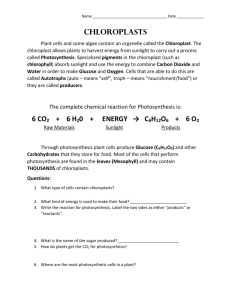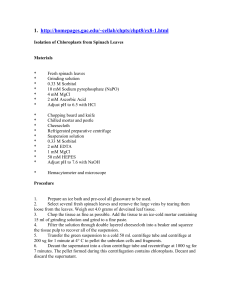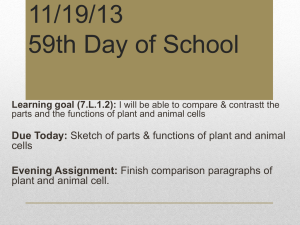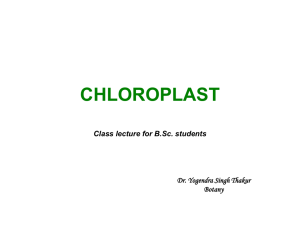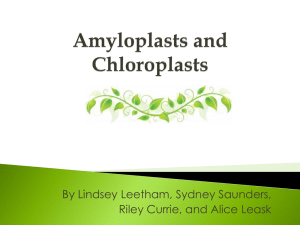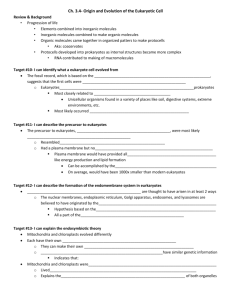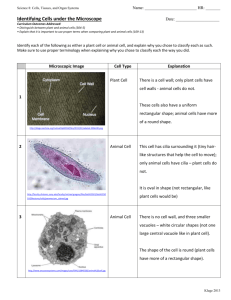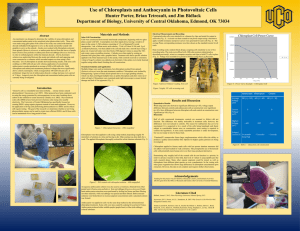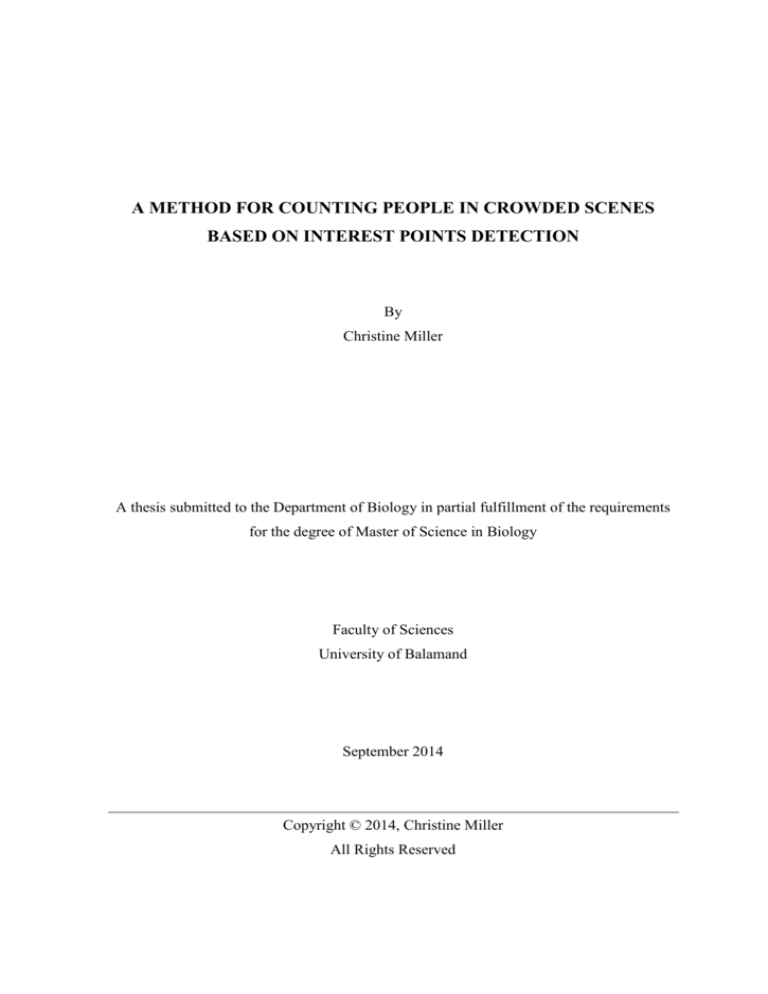
A METHOD FOR COUNTING PEOPLE IN CROWDED SCENES
BASED ON INTEREST POINTS DETECTION
By
Christine Miller
A thesis submitted to the Department of Biology in partial fulfillment of the requirements
for the degree of Master of Science in Biology
Faculty of Sciences
University of Balamand
September 2014
Copyright © 2014, Christine Miller
All Rights Reserved
ii
University of Balamand
Faculty of Sciences
This is to certify that I have examined this copy of a Master’s thesis by
Christine Miller
and have found that it is complete and satisfactory in all the respects,
and that any and all revisions required by the final
examining committee have been made.
JURY MEMBERS:
Approved:
… , Ph.D.
Supervisor
Approved:
… , Ph.D.
First Moderator
Approved:
…, Ph.D.
Second Moderator
Date of thesis defense: September 15, 2014
iii
ACKNOWLEDGEMENTS
I would like to express my sincere gratitude to my advisor Dr. … for his continuous
support, for his patience, motivation, enthusiasm, and immense knowledge. His guidance
helped me in all the time of research and writing of this thesis.
I would like to thank my family for supporting me spiritually throughout my life.
iv
ABSTRACT
Sea slugs of the genus Elysia (e.g. E. chlorotica) are known for their ability to
incorporate chloroplasts from the yellow-green alga Vaucheria litorea. These
“kleptoplasts” stay active in the digestive tract of the sea slug for several months.
Chloroplasts from Vaucheria litorea are also reported to be significantly more stable after
in vitro isolation than chloroplasts of other algae or of higher plants. In organello assays
with isolated chloroplasts are used in studies on photosynthetical and biochemical
processes in these organelles, chloroplast-nucleus communication, plant development and
plant responses to environmental changes. The major limiting factor of the chloroplast in
organello systems is the rapid decline in function and intactness of the plastids. This study
is investigating the stability and longevity of chloroplasts isolated from V. litorea and its
relative V. bursata in comparison to an angiosperm Pisum sativum. The structural
intactness of the chloroplasts was investigated by phase contrast microscopy and the
overall transcriptional activities were analyzed by run-on transcription assays.
v
TABLE OF CONTENTS
ACKNOWLEDGEMENTS
iii
ABSTRACT
iv
TABLE OF CONTENTS
v
LIST OF ABBREVIATIONS
vi
LIST OF TABLES
vii
LIST OF FIGURES
viii
CHAPTER 1: INTRODUCTION
1
1.1 The Chloroplast Genome
1
1.2 The Alga Vaucheria
3
1.2.1 Habitat and Phylogeny
4
1.2.2 Characteristics of Vaucheria Chloroplast
5
CHAPTER 2: Materials and Methods
15
2.1 Materials
16
2.1.1 Vaucheria and Pea – Media for cultivation and Chloroplast Isolation
2.1.1.1 Culture media for Vaucheria bursata
18
20
CHAPTER 5: CONCLUSION
73
LIST OF REFERENCES
76
APPENDIX A: Gene Maps
85
vi
LIST OF ABBREVIATIONS
32P
CTP Cytosine Triphosphate Containing Radioactive Phosphorus
33P
UTP Guanosine Triphosphate Containing Radioactive Phosphorus
ADP
Adenosine Diphosphate
EDTA
Ethylenediamine Tetraacetic Acid
Mrna
Messenger Ribonucleic Acid
NADP
Nicotinamide Adenine Dinucleotide Phosphate
NADPH
Reduced Nicotinamide Adenine Dinucleotide Phosphate
Pi
Inorganic Phosphate
PS
Photosystem 10
SSC
Standard Sodium Citrate
TAE
Tris Acetate EDTA
TBE
Tris Borate EDTA
TMV
Tobacco Mosaic Virus
vii
LIST OF TABLES
Table 1.1
Media for Micronutrient Solution
8
Table 2.1
Solutions for Percoll Step-Gradient
25
Table 2.2
Primers, Restriction Enzyme Specificity and Cut Sites and Expected
30
Fragment Sizes of the Amplified PCR Products
Table 3.4
Solutions and Concentrations for the SDS-PAGE
50
Table 4.6
Standard Sequencing Reaction Mix
70
viii
LIST OF FIGURES
Figure 1.1
Size Comparison of some Sequenced Genomes from Chloroplasts
5
of Higher Plants
Figure 2.1
The Chloroplast of Heterocont Alga Surrounded by Four
22
Membranes
Figure 3.6
Isolated Chloroplast of V. bursata
60
Figure 4.10
The percentage of Intact Chloroplasts Isolated from V. litorea and
71
V. bursata at different Time Points after Isolation based on Phase
Contrast Microscopy
1
CHAPTER 2
MATERIALS AND METHODS
2.2 Methods
2.2.1 Cultivation of Vaucheria bursata and Vaucheria litorea
All bottles used for algal cultures were new and never washed with a detergent, only
autoclaved before use. All handlings with the alga were done on a sterile bench and all
equipment used was sterilized with 70% EtOH and flamed. Few threads of algae were
inoculated in 20ml of medium in a small bottle with a lid.
2.2.2 Isolation of Intact Chloroplasts
Intact chloroplasts can be isolated from algae and higher plants by using
homogenization and differential centrifugation. After only one centrifugation, the crude
chloroplast pellet is a combination of intact and broken plastids and still contains some
plant debris. The chloroplasts can be further purified by isopycnic centrifugation on
discontinuous Percoll gradient. During the isolation, it is important to adjust the osmotic
value of all media to that of the cell to avoid osmotic shock and chloroplast burst
(Seigneurin-Berny et al., 2008).
2.2.2.1 Isolation of intact chloroplast from Vaucheria
All steps were conducted at 6°C using pre-cooled media and equipment. The algae
were collected with tweezers, washed twice in fresh growth medium and weighed. The
filaments were cut with a razor blade and then grinded gently in a few milliliters of
homogenization buffer.
2
Table 2.5: Specificity of Short (40 – 45bp) ssDNA Oligonucleotide Probes used for dot Blot
Hybridization Assay, Probes Targeting Chloroplast mRNA designed separately for Vaucheria and Pea
Gene
Specificity
psaA
Chlorophyll apoprotein of Photosystem I
psbA
Quinone-binding protein of Photosystem II
psbD
Chlorophyll apoprotein of Photosystem II
rbcL
Large subunit of ribulose bisphosphate carboxylase
rrn16
16S rRNA
rrn23
23S rRNA
trnE
Glutamine tRNA
pBS SK+
MCS in cloning vector pBS SK+, negative control of binding specificity
Figure 2.3: Map of the Vaucheria litorea Chloroplast Genome. Genes Annotated on the outside of the
DNA Representation are Transcribed in the Clockwise Direction, Genes of the inside are Transcribed
in the Counterclockwise Direction. Genes are Color Coded according to their Function as shown
(Rumpho et al., 2008)
3
LIST OF REFERENCES
Adam, Z. (1996). Protein stability and degradation in chloroplasts. Plant Molecular
Biology, 32, 773 – 786.
Andersen, R. A. & Bailey, J. C. (2002). Phylogenetic analysis of 32 strains of Vaucheria
(Xanthophyceae) using the rbcL gene and its two flanking spacer regions, Journal of
Phycology, 38(3), 583 – 592.
Bourne, D. H. & Danielli, J. F. (1981). International review of cytology, Volume 72. New
York: Academic Press.
Glover, D. M. & Hames, B. D. (1995). DNA cloning: Core techniques. (2nd ed.). New
York: Oxford University Press.
Suay, L., Salvador, M. L., Abesha, E. & Klein, U. (2005). Specific roles of 5’ RNA
secondary structures in stabilizing transcripts in chloroplasts. Nucleic Acids
Research, 33, 4754 – 4761.
Westphal S., Soll J. and Vothknecht U. C, (2001) A vesicle transport system inside
chloroplasts, FEBS Letters, Volume 506, pp. 257 - 261
Wilson, K. & Walker, J. (2000). Principals and techniques of practical biochemistry. (5th
ed.). Cambridge, U.K.: The Press Syndicate of the University of Cambridge.
4
APPENDIX A: Gene Maps
Gene maps of the chloroplast transformation vectors. The egfp sequence, coding for
enhanced green fluorescent protein, with the respective psbA promoters and rrnB T1
terminator were cloned into MSC of pBluescript SK+ cloning vector.
Figure A.1: Transformation Vector for P. sativum, Final Size 4 165 bp
Figure A.2: Transformation Vector for V. litorea, Final Size 4 876 bp



